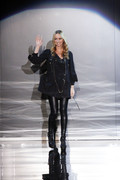
gucci.com
From gucci.com
FRIDA GIANNINI
Creative Director of Gucci
Frida Giannini’s unique talent and modern vision have fueled her rise as the leading creative force behind one of the world’s most celebrated fashion houses.
Born in Rome in 1972 to an architect father and art history professor mother, Giannini studied fashion design at Rome’s Fashion Academy before apprenticing in a small ready-to-wear house. In 1997, she went to Fendi where she worked as a ready-to-wear designer for three seasons before being named designer for Fendi leathergoods.
In September 2002 she joined Gucci as Handbag Design Director. Two years later she was appointed to a newly created post, Creative Director of Accessories, where she assumed unprecedented control of bags, shoes, luggage, small leathergoods, silks, fine jewelry, gifts, watches as well as eyewear. Giannini flourished in this expanded role, and brought a powerful new perspective to Gucci’s accessories collections.
Using the Gucci archives as a starting point, she transformed house classics such as the Flora scarf pattern and equestrian iconography into novel and hugely successful designs.
In 2005, she was named Creative Director of Gucci Women’s ready-to-wear, in addition to her responsibility for all accessories. In 2006, she took over menswear, thus rising to sole Creative Director of the label. Giannini accepted this significant responsibility with aplomb, quickly establishing her individual stamp on the house. Her design approach and focused management style are informed by sharp confidence and decisiveness, as well as her uniquely feminine and distinctly Italian point of view.
The combination has proven to be powerful, as witnessed by her consistent ability to design collections, which not only influence global fashion trends but that are also directional at retail.
Using the Gucci archives as a starting point, she transformed house classics such as the Flora scarf pattern and equestrian iconography into novel and hugely successful designs.
In 2005, she was named Creative Director of Gucci Women’s ready-to-wear, in addition to her responsibility for all accessories. In 2006, she took over menswear, thus rising to sole Creative Director of the label. Giannini accepted this significant responsibility with aplomb, quickly establishing her individual stamp on the house. Her design approach and focused management style are informed by sharp confidence and decisiveness, as well as her uniquely feminine and distinctly Italian point of view.
The combination has proven to be powerful, as witnessed by her consistent ability to design collections, which not only influence global fashion trends but that are also directional at retail.
Her broadening profile has allowed for increased social responsibility as well. She is deeply dedicated to and instrumental in Gucci’s continued partnership with UNICEF, and in February 2011, the US Fund for UNICEF recognized her with the inaugural Woman of Compassion award. In addition, Giannini is also on the Board of Directors of PPR’s Foundation for Women’s Dignity and Rights, an organization which fights violence against women and promotes their empowerment.
Giannini’s tenacity and unwavering vision have steered Gucci successfully into its 21st century guise. She is a new voice in fashion, one that champions a lighter luxury for modern times. Her innovative designs are a very personal interpretation of this venerable House: not only does she extract the very best of Gucci, but she has kept its privileged heritage firmly intact. Giannini’s strength of character and creative direction have earned her the Lupa Capitolina, awarded by the Mayor of Rome Gianni Alemanno, and a Design Star Honor from Fashion Group International.






























































